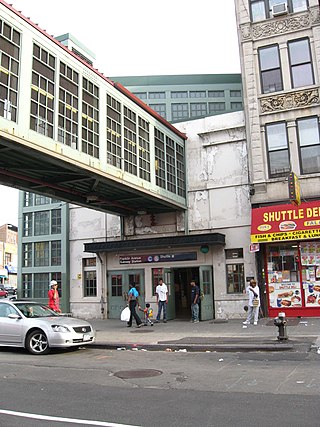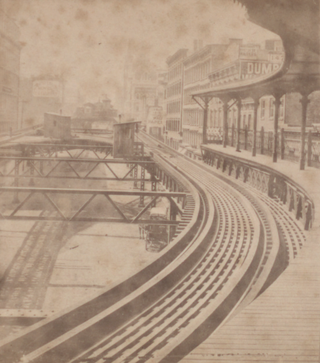The BMT Brighton Line, also known as the Brighton Beach Line, is a rapid transit line in the B Division of the New York City Subway in Brooklyn, New York City, United States. Local service is provided at all times by the Q train, but is joined by the B express train on weekdays. The Q train runs the length of the entire line from Coney Island–Stillwell Avenue to the Manhattan Bridge south tracks. The B begins at Brighton Beach and runs via the bridge's north tracks.

The Franklin Avenue station is a station complex shared by the BMT Franklin Avenue Line and the IND Fulton Street Line of the New York City Subway, located at Franklin Avenue and Fulton Street in Bedford–Stuyvesant, Brooklyn. It is served by the:
The 129th Street station was a transfer station on the IRT Third Avenue Line in Manhattan, New York City, shared by elevated trains of both the Third Avenue Line and IRT Second Avenue Line. The next stop to the north was 133rd Street for the main line and Willis Avenue for the Willis Avenue spur, both of which were across a swing bridge above the Harlem River in the Bronx. The next stop to the south was 125th Street−Third Avenue for Third Avenue Line trains and 125th Street−Second Avenue for Second Avenue Line trains.

The 42nd Street station was an elevated express station on the demolished IRT Third Avenue Line in Manhattan, New York City. It had two levels with the lower level having three tracks. The main line tracks were served by two side platforms. A side platform connected to the southbound platform was used for shuttle service to Grand Central. The upper level was built as part of the Dual Contracts, and had one track and two side platforms over the two local tracks.
The 34th Street station was a local station on the demolished IRT Third Avenue Line in Manhattan, New York City. The station was served by Third Avenue local trains and a shuttle to the 34th Street Ferry. Third Ave service originally had two tracks and two side platforms. During the Dual Contracts, a center express track was built. The shuttle to the ferry was served by two tracks and an island platform attached to the northbound side platform. North of the station the westbound track of the shuttle merged with the main line.
The 57th Street station was an express station on the demolished IRT Second Avenue Line in Manhattan, New York City. It had two levels. The lower level had three tracks and two island platforms and served trains coming from the Bronx. The upper level had two tracks and one island platform and served trains coming from Queens, from the IRT Flushing Line, and IRT Astoria Line. The next stop to the north was 65th Street for local trains going to the Bronx, and Queensboro Plaza for trains going to Queens. The next express stop was 86th Street on Bronx-bound trains. The next stop to the south was 50th Street for all local trains and 42nd Street for express trains. The station closed on June 13, 1942, although trains to the Bronx stopped serving it on June 11, 1940.
The 50th Street station was a local station on the demolished IRT Second Avenue Line in Manhattan, New York City. It had three tracks and two side platforms. The next stop to the north was 57th Street. The next stop to the south was 42nd Street. The station closed on June 13, 1942.
The 42nd Street station was an express station on the demolished IRT Second Avenue Line in Manhattan, New York City. It had three tracks and two island platforms. The next stop to the north was 50th Street for local trains and 57th Street for express trains. The next stop to the south was 34th Street for local trains and 14th Street for express trains. The station closed on June 13, 1942.
The 23rd Street station was a station on the demolished IRT Second Avenue Line in Manhattan, New York City. It had two levels. The lower level had two tracks and two side platforms and served local trains. The upper level had one track for express trains. The next stop to the north was 34th Street. The next stop to the south was 19th Street. The station closed on June 13, 1942.
The 14th Street station was an express station on the demolished IRT Second Avenue Line in Manhattan, New York City, located at the intersection of 14th Street and First Avenue. It had two levels. The lower level had three tracks and two side platforms and was served by local trains. The upper level had two tracks and two side platforms and was used by express trains. The next stop to the north was 19th Street for local trains and 42nd Street for express trains. The next stop to the south was Eighth Street for local trains and Chatham Square for express trains. The station closed on June 13, 1942.
The Eighth Street station was a local station on the demolished IRT Second Avenue Line in Manhattan, New York City, located at the intersection of Eighth Street and First Avenue. It had two levels. The lower level had two tracks and two side platforms and the upper level had one track that served express trains. The next stop to the north was 14th Street. The next stop to the south was First Street. The station closed on June 13, 1942.
The First Street station was a local station on the demolished IRT Second Avenue Line in Manhattan, New York City, located at the intersection of First Street and First Avenue. It had two levels. The lower level had two tracks and two side platforms and the upper level had one track that served express trains. The station opened on March 1, 1880, and closed on June 13, 1942.
The Rivington Street station was a local station on the demolished IRT Second Avenue Line in Manhattan, New York City. It had two levels. The lower level had two tracks and two side platforms while the upper level had one track that served the express trains. The next stop to the north was First Street. The next stop to the south was Grand Street. The station closed on June 13, 1942.
The Grand Street station was a local station on the demolished IRT Second Avenue Line in Manhattan, New York City. It had two levels. The lower level had two tracks and two side platforms and the upper level had one track that served the express trains. The next stop to the north was Rivington Street. The next stop to the south was Canal Street. The station closed on June 13, 1942.
The Canal Street station was a station on the demolished IRT Second Avenue Line in Manhattan, New York City. It had two levels. The lower level had two tracks and two side platforms and the upper level had one track that served the express trains. The next stop to the north was Grand Street. The next stop to the south was Chatham Square. The station closed on June 13, 1942.
The 30th Street station was a local station on the demolished IRT Ninth Avenue Line in Manhattan, New York City. It was opened on December 13, 1873 as the replacement for the original northern terminus of the Ninth Avenue Line at 29th Street, which was built in 1868 The station which was originally built by the New York Elevated Railroad Company had two levels. The lower level was built first and had two tracks and two side platforms. The upper level was built as part of the Dual Contracts and had one track that served express trains that bypassed the station. It closed on June 11, 1940. The next southbound stop was 23rd Street. The next northbound stop was 34th Street.
The 66th Street station was an express station on the demolished IRT Ninth Avenue Line in Manhattan, New York City. It had two levels. The lower level was built first and had two tracks and two side platforms. The upper level was built as part of the Dual Contracts and had one track and two side platforms over the lower level local tracks. The station closed on June 11, 1940. The next southbound local stop was 59th Street. The next southbound express stop was 34th Street for Ninth Avenue trains, and 50th Street for IRT Sixth Avenue Line express trains. The next northbound local stop was 72nd Street. The next northbound express stop was 116th Street. The express run from this stop to 116th Street was the longest express segment out of all New York City elevated lines, bypassing seven local stations.

The 42nd Street station was a local station on the demolished IRT Ninth Avenue Line in Manhattan, New York City. It was opened on November 6, 1875, and had two levels. On the lower level, the local trains stopped, on two tracks serving two side platforms. The upper level was built as part of the Dual Contracts and had one track which carried express trains bypassing the station. The next northbound stop was 50th Street. The next southbound stop was 34th Street. The station was closed on June 11, 1940.
The 19th Street station was a local station on the demolished IRT Second Avenue Line in Manhattan, New York City. It had two levels. The lower level had two tracks and two side platforms and served local trains. The upper level had one track for express trains. The next stop to the north was 23rd Street. The next stop to the south was 14th Street. The station closed on June 13, 1942.







